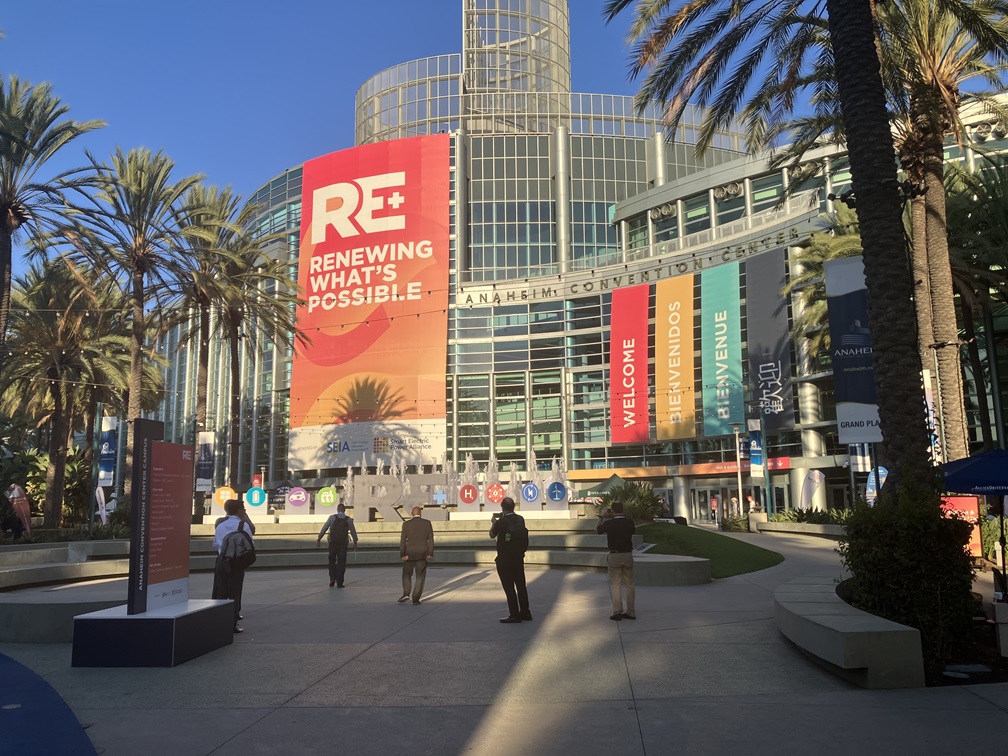
From leading players to startups, here are some tasty quotes from interviews taped at RE+ this week in Anaheim, California, US.
This year’s RE+, as you have probably heard by now, brought more than 50,000 people from across the industry to California. There’s just one day left before it closes its doors, but the packed halls and auditoriums will leave attendees with perhaps years of learnings to unpack when they get home.
Enjoy 12 months of exclusive analysis
- Regular insight and analysis of the industry’s biggest developments
- In-depth interviews with the industry’s leading figures
- Annual digital subscription to the PV Tech Power journal
- Discounts on Solar Media’s portfolio of events, in-person and virtual
Or continue reading this article for free
Energy-Storage.news is no different. With about a dozen or more interviews in the bag and a long commitment ahead to getting all of those insights and opinions into publishable form, we thought we could at least give you some choice snippets to chew on until then.
Welcome to ESS 3.0
“I think that in the early 2010s, [the industry was] ‘ESS 1.0,’ with pilot projects to prove the technology. Then, I would say around 2016 and 2017, it became ESS 2.0: where there are capacity markets created, energy markets created, and there were some projects that made economic sense,” says Jaehong Park, CEO of LG ES Vertech, the battery manufacturer’s US-based system integrator subsidiary.
“Now, we are moving towards ESS 3.0. The definition of that is that ESS is no longer a pilot project or just projects relying on incentive programmes; it’s really a part of the grid infrastructure now, it’s part of the clean energy infrastructure.
“Since it’s part of the infrastructure, what we need to work on is efficiency: we are improving the energy density, working on round-trip efficiency, and working on better availability. Our focus should be on hardware efficiency in addition to the data analytics and software side of things.”
Election fuelling uncertainty
“When I talk to clients, the biggest thing that I’m hearing from them right now is just concern about what the administration is going to do after the election, what changes in regulations are going to be there,” says Joshua Crawford, energy storage technology lead for engineering, procurement and construction (EPC) firm Burns & McDonnell.
“There are concerns about cybersecurity and the regulations on where they can get their batteries and their technology from, and so all of the customers are kind of trying to figure out where that’s going to go. The suppliers are too, and they’re all taking different approaches to it.”
Clean energy needs a ‘Got Milk?’ moment

“I think that it’s an incredibly exciting, interesting time in the energy industry. We need more people that are committed to the cause right now to make the energy transition [away from fossil fuels to renewables and storage],” says Luigi Resta, CEO of solar PV, wind, battery storage and pumped hydro developer RPlus Energies.
“Another thing is that as an industry we need to come up with a better, more collaborative approach to marketing what we do. I’ve compared it to the ‘Got Milk?’ campaign, but we need to, as an industry, get out into rural USA and say: ‘Hey, this is good, this is domestic, this is dispatchable, it has all of these benefits, that it’s not foreign adversaries coming here to try and do. Developing renewable energy projects in these communities is a domestic, diversity approach to [improving] the quality of our life.”
Your warranty is valid only if the manufacturer stays in business
“Your warranty is only valid as long as the manufacturer exists,” says Arthur Claire, director of technology at quality assurance and factory inspection services provider Sinovoltaics.
“Right now, many companies are reducing costs, reducing prices and reducing margins, which is putting many manufacturers at risk. I think in Europe and in the US we are really good at promising a lot of things.
“When you read the news, you get the feeling we have dozens of gigafactories in Europe and in the US. In China, they build the factory, and then they talk about it. That’s a massive difference and we didn’t [as an industry] anticipate that Chinese products would flow into the US and into Europe as they are now, and that the quality would be as good, at such a low price.”
Thermal runaway is the biggest risk
“The biggest thing that we’re looking at as an insurer, is thermal runaway risk. These battery fires are something that we’re keeping a close eye on as an insurer,” says Adam Shinn of specialist renewables and storage insurance company kWh Analytics.
“Each time one of these fires happens, we’ve seen local jurisdictions step up and say, ‘Wait a second, there are so many more batteries coming online in my state, in my county, how are we going to deal with this?’ That’s why we saw New York coming out with some really great recommendations to change the Fire Code, the same thing we’ve seen in Arizona, California and other places go the same route and each time to learn from these incidents.”
Read an article on BESS fire safety and insurance, co-authored by kWh Analytics’ Adam Shinn, in the latest edition of our journal, PV Tech Power (Vol.40), available to ESN Premium subscribers.
Fire does not have to be an inevitability
“I was talking to an IPP who recently had a fire, and they were telling me they’re trying to prepare their messaging along the lines that fire is an inevitability. They’re trying to position it around: if you look at the percentage of storage systems deployed versus the amount on fire, it’s a very small percentage,” says Andy Tang, VP of energy storage and optimisation for Wärtsilä Energy.
“I do believe that statistic is factually correct; that’s a true statement. I reject the premise that fire is an inevitability. It doesn’t have to be, but you’ve got to pay for that.
There is a level of due diligence that you can do, and there is a premium that you can pay that greatly reduces your risk.”
Utilities and market operators’ priority is reliability
“What we see happening is that places that have high penetration of renewables are where battery storage is needed the fastest, and that’s where you see the challenges [in finding opportunities to develop projects] start to diminish,” says Tim Allen, CEO of grid control software player PXiSE Energy Solutions.
“That doesn’t mean there are no challenges, but if you’re trying to push batteries into a market where there isn’t a big reliability problem, and it’s all about economics, you can find opportunities like ToU arbitrage, things like that, but you’re not going to find a big pull from the utilities – until it becomes a reliability problem. You’re not going to find a big pull from a market operator until becomes a reliability problem.
“When you see what’s happening in ERCOT with all the wind and solar being built, suddenly, it became a reliability problem, and so they started making it very easy and lucrative to bring battery storage online. In Australia, they’re putting in renewables at an alarmingly fast pace and then, suddenly, their grid starts to become unstable, and boom, they start incentivising battery storage.”


